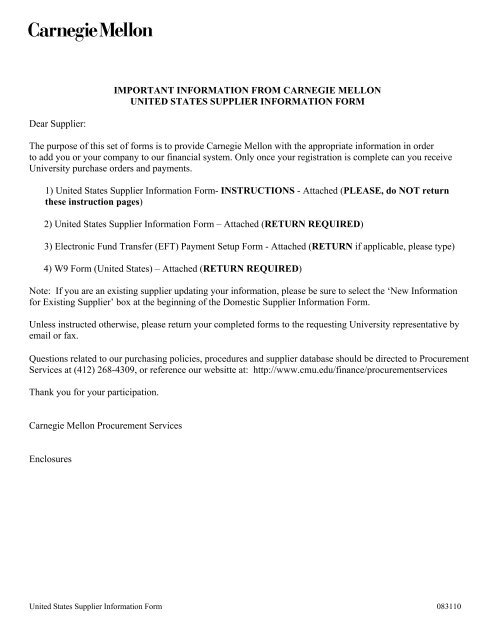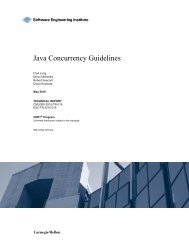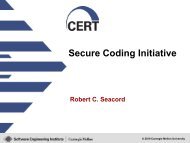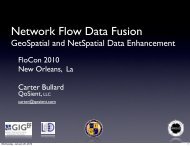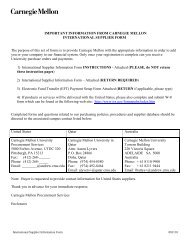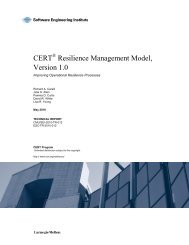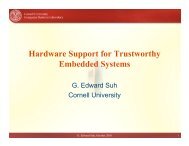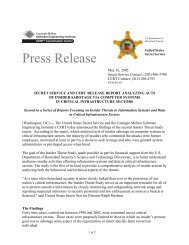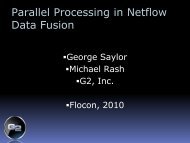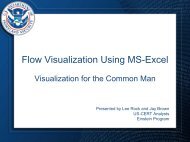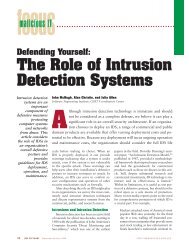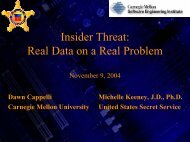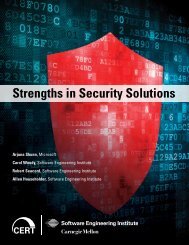United States Supplier Information Form - Cert
United States Supplier Information Form - Cert
United States Supplier Information Form - Cert
You also want an ePaper? Increase the reach of your titles
YUMPU automatically turns print PDFs into web optimized ePapers that Google loves.
IMPORTANT INFORMATION FROM CARNEGIE MELLON<br />
UNITED STATES SUPPLIER INFORMATION FORM<br />
Dear <strong>Supplier</strong>:<br />
The purpose of this set of forms is to provide Carnegie Mellon with the appropriate information in order<br />
to add you or your company to our financial system. Only once your registration is complete can you receive<br />
University purchase orders and payments.<br />
1) <strong>United</strong> <strong>States</strong> <strong>Supplier</strong> <strong>Information</strong> <strong>Form</strong>- INSTRUCTIONS - Attached (PLEASE, do NOT return<br />
these instruction pages)<br />
2) <strong>United</strong> <strong>States</strong> <strong>Supplier</strong> <strong>Information</strong> <strong>Form</strong> – Attached (RETURN REQUIRED)<br />
3) Electronic Fund Transfer (EFT) Payment Setup <strong>Form</strong> - Attached (RETURN if applicable, please type)<br />
4) W9 <strong>Form</strong> (<strong>United</strong> <strong>States</strong>) – Attached (RETURN REQUIRED)<br />
Note: If you are an existing supplier updating your information, please be sure to select the ‘New <strong>Information</strong><br />
for Existing <strong>Supplier</strong>’ box at the beginning of the Domestic <strong>Supplier</strong> <strong>Information</strong> <strong>Form</strong>.<br />
Unless instructed otherwise, please return your completed forms to the requesting University representative by<br />
email or fax.<br />
Questions related to our purchasing policies, procedures and supplier database should be directed to Procurement<br />
Services at (412) 268-4309, or reference our websitte at: http://www.cmu.edu/finance/procurementservices<br />
Thank you for your participation.<br />
Carnegie Mellon Procurement Services<br />
Enclosures<br />
<strong>United</strong> <strong>States</strong> <strong>Supplier</strong> <strong>Information</strong> <strong>Form</strong> 083110
Official Use Only:<br />
Is this supplier in the EPLS?<br />
Yes No<br />
UNITED STATES SUPPLIER INFORMATION FORM<br />
RETURN TO:<br />
New <strong>Supplier</strong> Carnegie Mellon University<br />
New <strong>Information</strong> for Existing <strong>Supplier</strong> 5000 Forbes Avenue, Pittsburgh, PA 15213<br />
(Submit with appropriate W9 form found at:<br />
Attn:______________________________________<br />
http://www.irs.gov/formspubs/index.html or http://www.cmu.edu/finance/forms) [ Department & Person Name ]<br />
Federal law requires Carnegie Mellon to provide “Taxpayer Reporting <strong>Information</strong>” (1099/1042 forms) to the Federal<br />
Government and payee on certain types of payments. All fields in bold are required, unless specified. Please type or print.<br />
1. SUPPLIER<br />
__________________________________________________________________<br />
____________________________<br />
Legal Name (Must match Line 1 of W-9 to avoid backup withholding.)<br />
Federal Tax ID or Social Security<br />
___________________________________________________________________<br />
____________________________<br />
DBA (Doing Business As, if applicable)<br />
DUNS Number<br />
NAICS # ________________________ (Go to www.census.gov/epcd/www/naics.html) U.S. Census Bureau NAICS<br />
(REQUIRED for ALL SUPPLIERS doing business with Carnegie Mellon – Use 2007 NAICS Search)<br />
Is Payee a US Citizen? Ο Yes Ο No<br />
If no, Foreign National <strong>Information</strong> <strong>Form</strong> For Non-Employees Required.<br />
(http://www.cmu.edu/finance/forms) (search here)<br />
Type of Organization (select all applicable)<br />
<strong>Supplier</strong> Diversity <strong>Information</strong><br />
Ο Individual (Social Security Number)* Ο Incorporated (Federal ID No.) (See Instruction Sheets)<br />
Ο Sole Proprietor (Federal ID No.)* Ο Legal Services Ο Women-owned (WBE)<br />
Ο Limited Liability Company* Ο Medical Services Ο Veteran-owned<br />
Ο Partnership (Federal ID No.) Ο S Corporation Ο Service Disabled Veteran-owned<br />
Ο Non-Profit Organization (Federal ID No.) Ο Hotel Ο HUB Zone<br />
Ο Government Entity (Federal ID No.)<br />
Ο HBCU / MI<br />
Ο Disadvantaged (DBE)/Minority (MBE)<br />
Business Size (select one)<br />
(Continue Below)<br />
Ο Large Business Concern<br />
Ο Small Business Concern<br />
* (Note: Individuals and Sole Proprietors must complete the Independent Contractor Checklist. This form is available at:<br />
http://www.cmu.edu/finance/forms/procurement/index.html))<br />
Please check the Disadvantaged Business Entity classification below, if applicable:<br />
Ο Black American Ο Native American Ο Asian American Ο Hispanic American Ο Other __________________<br />
(Misrepresentation – Reference: Small Business Program Representations – FAR Part 52.219-[d][2])<br />
Are you Central Contractor Registration <strong>Cert</strong>ified: Ο Yes Ο No (www.ccr.gov) Attach copy of <strong>Cert</strong>ification<br />
Are you SBA <strong>Cert</strong>ified: Ο Yes Ο No<br />
agency. <strong>Cert</strong>ifying Agency:<br />
Please attach a copy of <strong>Supplier</strong> Diversity <strong>Cert</strong>ification and the name of the certifying<br />
Has your company been included on the List of Parties Excluded from Federal Procurement Programs within the last 3 years?<br />
Ο Yes Ο No (Ref: http://www.epls.gov/)<br />
Other <strong>Cert</strong>ifications: __________________________________________________________________ (Attach copy of <strong>Cert</strong>ification)<br />
2. GENERAL<br />
Description of product or services being offered to Carnegie Mellon, and their location:<br />
(e.g. – Manufacturer of Electron Microscopes delivered to Qatar, or Service Provider of Team Training Programs in Pittsburgh, PA)<br />
Company Web Site: ___________________________________________________________________________________________<br />
Year Established Number of Employees Gross Annual Sales Awards<br />
Terms: FOB Delivered, Net 30 unless otherwise acknowledged by an authorized signatory for Carnegie Mellon University.<br />
Does any individual employed by Carnegie Mellon University have a significant interest in your business? Ο Yes<br />
If yes, please provide the Employee Name and describe the relationship:<br />
Ο No<br />
<strong>United</strong> <strong>States</strong> <strong>Supplier</strong> <strong>Information</strong> <strong>Form</strong> 083110
3. BUSINESS ADDRESSES<br />
ADDRESS/LOCATION 1<br />
Line 1_________________________________________<br />
Line 2_________________________________________<br />
City___________________________________________<br />
State/Zip_______________________________________<br />
County________________________________________<br />
ADDRESS/LOCATION 2 (if applicable)<br />
Line 1____________________________________________________<br />
Line 2____________________________________________________<br />
City______________________________________________________<br />
State/Zip__________________________________________________<br />
County___________________________________________________<br />
Is ADDRESS 1: Is ADDRESS 2:<br />
Payment Receiving Site? Ο Yes Ο No<br />
Payment Receiving Site? Ο Yes Ο No<br />
Purchasing Site? Ο Yes Ο No Purchasing Site? Ο Yes Ο No<br />
Telephone Number_______________________________<br />
Fax Number _____________________________________<br />
Telephone Number_________________________________________<br />
Fax Number _______________________________________________<br />
4. CONTACTS<br />
Primary Contact Name __________________________<br />
E-mail Address _________________________________<br />
Telephone Number ______________________________<br />
Fax Number ___________________________________<br />
Sales Rep. Contact Name ____________________________________<br />
E-mail Address _____________________________________________<br />
Telephone Number __________________________________________<br />
Fax Number _______________________________________________<br />
5. Name of Carnegie Mellon employee with whom you’ve been speaking: ____________________________________________<br />
6. PAYMENT<br />
a) Does your company accept credit card payments? O Visa O American Express O MasterCard<br />
b) Will you accept electronic fund transfers? O Yes O No<br />
If yes, complete and submit the Electronic Funds Transfer (EFT) Payment Setup <strong>Form</strong> attached.<br />
Note: Payments made in US Dollars<br />
7. SIGNATURE & CERTIFICATION<br />
I certify that the number shown on this form is my correct Taxpayer Identification Number and all other responses provided herein,<br />
including vendor classifications, are true and accurate. I will contact Carnegie Mellon if there is a change in the data or relationship with<br />
the University.<br />
___________________ _________________________<br />
Signature of Authorized Representative Date Telephone Number<br />
___________________<br />
_________________________<br />
Name (Printed or Typed) Title E-mail address<br />
Internal Carnegie Mellon Departmental Use Only: (to be filled out by Carnegie Mellon Departmental Buyer)<br />
Please select the appropriate set of books where this supplier is to be added, based on Oracle String charged.<br />
US Qatar Australia<br />
CM Department is required to fill this section out prior to any input into the <strong>Supplier</strong> Database<br />
<strong>United</strong> <strong>States</strong> <strong>Supplier</strong> <strong>Information</strong> <strong>Form</strong> 083110
Domestic <strong>Supplier</strong> <strong>Information</strong> <strong>Form</strong> Instructions and Definitions<br />
Do Not Return This Sheet<br />
SECTION 1 - (Each part of Section 1 is required in order to be entered into the Carnegie Mellon automated payment<br />
system.)<br />
NAICS - North American Industrial Classification System (www.census.gov/epcd/www/naics.html): Use the 2007 NAICS<br />
Search box in the top-left hand corner of the page to find your six digit NAICS code (e.g. 711130 = Musical Groups &<br />
Artists, 923110 = Administration of Education Programs, etc.)<br />
NON-PROFIT ORGANIZATION: Any organization not conducted or maintained for the purpose of making profit. This<br />
category includes but is not limited to sheltered workshops, universities, colleges, and local, state and federal<br />
governments.<br />
LARGE BUSINESS CONCERN: Any organization/business that is larger than a SMALL BUSINESS CONCERN.<br />
SMALL BUSINESS CONCERN: (a) The SBA establishes small business size standards on an industry-by-industry basis.<br />
(See 13 CFR 121.) (b) Small business size standards are applied by-- (1) Classifying the product or service being<br />
acquired in the industry whose definition, as found in the North American Industry Classification System (NAICS)<br />
Manual (available via the Internet at http://www.census.gov/epcd/www/naics.html) best describes the principal nature of<br />
the product or service being acquired.<br />
WOMAN-OWNED SMALL BUSINESS CONCERN means a small business concern-- (a) Which is at least 51 percent<br />
owned by one or more women; or, in the case of any publicly owned business, at least 51 percent of the stock of which is<br />
owned by one or more women; and (b) Whose management and daily business operations are controlled by one or more<br />
women.<br />
VETERAN-OWNED SMALL BUSINESS CONCERN means a small business concern-- (a) Which is at least 51 percent<br />
owned by one or more veterans; or, in the case of any publicly owned business, at least 51 percent of the stock of which<br />
is owned by one or more veterans; and (b) Whose management and daily business operations are controlled by one or<br />
more veterans.<br />
SERVICE DISABLED VETERAN-OWNED SMALL BUSINESS CONCERN means a small business concern-- (a) Which is<br />
at least 51 percent owned by one or more service disabled veterans; or, in the case of any publicly owned business, at<br />
least 51 percent of the stock of which is owned by one or more service disabled veterans; and (b) Whose management<br />
and daily business operations are controlled by one or more service disabled veterans.<br />
HUBZone Small Business Concern means a small business that appears on the List of Qualified HUBZone Small<br />
Business Concerns maintained by the Small Business Administration. The acronym HUBZone stands for a Historically<br />
Underutilized Business Zone, which is an area located within one or more qualified census tracts, qualified nonmetropolitan<br />
counties, or lands within the external boundaries of an Indian reservation.<br />
HBCU/MI: A historically Black College or University/ Minority Institution.<br />
SMALL DISADVANTAGED BUSINESS CONCERN means an offerer that represents, as part of its offer, that it is a small<br />
business under the size standard applicable to the acquisition; and it has received certification as a small disadvantaged<br />
business concern consistent with 13 CFR part 124, subpart B; and<br />
(i) No material change in disadvantaged ownership and control has occurred since its certification;<br />
(ii) Where the concern is owned by one or more disadvantaged individuals, the net worth of each individual upon whom<br />
the certification is based does not exceed $750,000 after taking into account the applicable exclusions set forth at 13<br />
CFR 124.104(c)(2); and<br />
(iii) It is identified, on the date of its representation, as a certified small disadvantaged business (SDB) concern in the<br />
database maintained by the Small Business Administration (Central Contractor Registration [CCR] http://www.ccr.gov/);<br />
Definitions of DBE business classifications are as follows:<br />
Black American: All persons having origin in any of the African racial groups.<br />
Native American: All persons having origins in any of the original peoples of North America, including American Indian,<br />
Alaskan Native, Aleut or Native Hawaiian.<br />
Asian American: All persons whose origins are in India, Pakistan or Bangladesh, Japan, China, Vietnam, Korea, Samoa,<br />
Guam, the U.S. Trust Territory of the Pacific Islands, the Northern Mariana Islands, Laos, Cambodia, Taiwan or the<br />
Philippine Islands.<br />
Hispanic American: All persons of Mexican, Puerto Rican, Cuban, Central, Latin or South American, Portuguese or other<br />
Spanish culture of origin.<br />
SECTION 2 - The fields in bold are required.<br />
SECTION 3 - At least one address is required.<br />
SECTION 4 - Required.<br />
SECTION 5 - Required.<br />
SECTION 6 - Complete as applicable.<br />
SECTION 7 - Required. The <strong>United</strong> <strong>States</strong> <strong>Supplier</strong> <strong>Information</strong> <strong>Form</strong> must be signed by an authorized<br />
representative of the company or the individual providing the service(s) if not a corporate legal entity.<br />
Do not fill in any information in the box used for Internal Carnegie Mellon Departmental <strong>Information</strong>.<br />
<strong>United</strong> <strong>States</strong> <strong>Supplier</strong> <strong>Information</strong> <strong>Form</strong> 083110
5000 Forbes Avenue<br />
Pittsburgh, PA 15213-3890<br />
Electronic Funds Transfer (EFT)<br />
Payment Setup <strong>Form</strong><br />
Carnegie Mellon is implementing globalization initiatives and is now offering payment options in US dollars<br />
as well as and campus local currencies to its international suppliers that wish to receive payment for goods<br />
and services through electronic funds transfer. The advantage to this form of payment is funds are<br />
electronically deposited directly into your company’s designated bank account through ACH (Automated<br />
Clearing House). For your company to begin receiving payments electronically, please complete the<br />
accompanying form. We encourage your participation!<br />
EFT Options<br />
• CCD+(CCP) – Cash Concentration/Disbursement – Payment is issued electronically to your<br />
company’s bank, but remittance advice is transferred via another medium. Your remittance advice<br />
options are as follows: (NOTE: You may only choose 1 option)<br />
o EMAIL – Remittance Advice is emailed to a designated address that your company provides.<br />
This email address can be a group list.<br />
o MAIL – Remittance Advice is mailed to a designated address that your company provides.<br />
o FAX – Remittance Advice is faxed to a designated fax number that your company provides.<br />
(For US Dollar payments initiated from a US bank only)<br />
• CTX – Corporate Trade Exchange – Payment and Remittance Advice are issued electronically to<br />
your company’s bank. Your bank then provides you with notification/remittance information<br />
regarding the payment.<br />
o NOTE: It is recommended that you verify with your bank on their capabilities to handle this<br />
type of electronic information.<br />
Carnegie Mellon’s Accounts Payable department is available Monday through Friday, 9:00 am – 5:00 pm<br />
ET. Please address any questions to Adam Rauf 412-268-8442. It is your responsibility to notify us if there<br />
are any changes to the information on the EFT form.<br />
We look forward to hearing from you!<br />
Carnegie Mellon Procurement Services<br />
<strong>United</strong> <strong>States</strong> <strong>Supplier</strong> <strong>Information</strong> <strong>Form</strong> 083110
Official Use Only:<br />
5000 Forbes Avenue<br />
Pittsburgh, PA 15213-3890<br />
US<br />
International<br />
Electronic Funds Transfer (EFT) (Please type and fill out completely)<br />
Payment Setup <strong>Form</strong><br />
Request Type (check one):<br />
Initiate Alter<br />
<strong>Supplier</strong> <strong>Information</strong><br />
<strong>Supplier</strong> Name (please type or print):_______________________________________________________<br />
<strong>Supplier</strong> Address (City, State, Zip): ________________________________________________________<br />
<strong>Supplier</strong> Country:_______________________________________________________________________<br />
Contact Name/Phone:___________________________________________________________________<br />
Email Address (required):________________________________________________________________<br />
Bank <strong>Information</strong><br />
Bank Name:___________________________________________________________________________<br />
Bank Address (City, State, Zip): ___________________________________________________________<br />
Bank County: __________________________________________________________________________<br />
Account Name: ________________________________________________________________________<br />
Bank Routing Number (Domestic only): ____________________________________________________<br />
BSB Number (International only): _________________________________________________________<br />
Bank Account Number:__________________________________________________________________<br />
S.W.I.F.T. Code (8 or 11 characters, International only): _______________________________________<br />
Bank Account Type: ____Checking ____Savings<br />
Currency Type: ________________________________________________________________________<br />
Remittance Options<br />
• CCD+ (CCP) Payments (Please select only one)<br />
EMAIL - Receive Remittance Advice via EMAIL<br />
Remittance Email Address: ______________________________________________________<br />
MAIL - Receive Remittance Advice via MAIL<br />
Address/City/State/Zip (if different from above): Please provide ‘ATTN TO’ Contact<br />
____________________________________________________________________________<br />
FAX - Receive Remittance Advice via FAX<br />
Remittance Fax # / ‘ATTN TO’ Contact: ____________________________________________<br />
(For US Dollar payments initiated from a US bank only)<br />
• CTX Payments<br />
Do not route (remittance contained in electronic file)<br />
Authorized Signatory*: _________________________________ Date: ___________________________<br />
Print Name: __________________________________________ Title: ___________________________<br />
Telephone #: __________________________________________________________________________<br />
<strong>United</strong> <strong>States</strong> <strong>Supplier</strong> <strong>Information</strong> <strong>Form</strong> 083110
<strong>Form</strong> W-9<br />
(Rev. January 2011)<br />
Department of the Treasury<br />
Internal Revenue Service<br />
Name (as shown on your income tax return)<br />
Request for Taxpayer<br />
Identification Number and <strong>Cert</strong>ification<br />
Give <strong>Form</strong> to the<br />
requester. Do not<br />
send to the IRS.<br />
Print or type<br />
See Specific Instructions on page 2.<br />
Business name/disregarded entity name, if different from above<br />
Check appropriate box for federal tax<br />
classification (required): Individual/sole proprietor C Corporation S Corporation Partnership Trust/estate<br />
Exempt payee<br />
Limited liability company. Enter the tax classification (C=C corporation, S=S corporation, P=partnership) ▶<br />
Other (see instructions) ▶<br />
Address (number, street, and apt. or suite no.)<br />
Requester’s name and address (optional)<br />
City, state, and ZIP code<br />
List account number(s) here (optional)<br />
Part I Taxpayer Identification Number (TIN)<br />
Enter your TIN in the appropriate box. The TIN provided must match the name given on the “Name” line<br />
to avoid backup withholding. For individuals, this is your social security number (SSN). However, for a<br />
resident alien, sole proprietor, or disregarded entity, see the Part I instructions on page 3. For other<br />
entities, it is your employer identification number (EIN). If you do not have a number, see How to get a<br />
TIN on page 3.<br />
Note. If the account is in more than one name, see the chart on page 4 for guidelines on whose<br />
number to enter.<br />
Social security number<br />
–<br />
– –<br />
Employer identification number<br />
Part II <strong>Cert</strong>ification<br />
Under penalties of perjury, I certify that:<br />
1. The number shown on this form is my correct taxpayer identification number (or I am waiting for a number to be issued to me), and<br />
2. I am not subject to backup withholding because: (a) I am exempt from backup withholding, or (b) I have not been notified by the Internal Revenue<br />
Service (IRS) that I am subject to backup withholding as a result of a failure to report all interest or dividends, or (c) the IRS has notified me that I am<br />
no longer subject to backup withholding, and<br />
3. I am a U.S. citizen or other U.S. person (defined below).<br />
<strong>Cert</strong>ification instructions. You must cross out item 2 above if you have been notified by the IRS that you are currently subject to backup withholding<br />
because you have failed to report all interest and dividends on your tax return. For real estate transactions, item 2 does not apply. For mortgage<br />
interest paid, acquisition or abandonment of secured property, cancellation of debt, contributions to an individual retirement arrangement (IRA), and<br />
generally, payments other than interest and dividends, you are not required to sign the certification, but you must provide your correct TIN. See the<br />
instructions on page 4.<br />
Sign<br />
Here<br />
Signature of<br />
U.S. person ▶<br />
General Instructions<br />
Section references are to the Internal Revenue Code unless otherwise<br />
noted.<br />
Purpose of <strong>Form</strong><br />
A person who is required to file an information return with the IRS must<br />
obtain your correct taxpayer identification number (TIN) to report, for<br />
example, income paid to you, real estate transactions, mortgage interest<br />
you paid, acquisition or abandonment of secured property, cancellation<br />
of debt, or contributions you made to an IRA.<br />
Use <strong>Form</strong> W-9 only if you are a U.S. person (including a resident<br />
alien), to provide your correct TIN to the person requesting it (the<br />
requester) and, when applicable, to:<br />
1. <strong>Cert</strong>ify that the TIN you are giving is correct (or you are waiting for a<br />
number to be issued),<br />
2. <strong>Cert</strong>ify that you are not subject to backup withholding, or<br />
3. Claim exemption from backup withholding if you are a U.S. exempt<br />
payee. If applicable, you are also certifying that as a U.S. person, your<br />
allocable share of any partnership income from a U.S. trade or business<br />
is not subject to the withholding tax on foreign partners’ share of<br />
effectively connected income.<br />
Date ▶<br />
Note. If a requester gives you a form other than <strong>Form</strong> W-9 to request<br />
your TIN, you must use the requester’s form if it is substantially similar<br />
to this <strong>Form</strong> W-9.<br />
Definition of a U.S. person. For federal tax purposes, you are<br />
considered a U.S. person if you are:<br />
• An individual who is a U.S. citizen or U.S. resident alien,<br />
• A partnership, corporation, company, or association created or<br />
organized in the <strong>United</strong> <strong>States</strong> or under the laws of the <strong>United</strong> <strong>States</strong>,<br />
• An estate (other than a foreign estate), or<br />
• A domestic trust (as defined in Regulations section 301.7701-7).<br />
Special rules for partnerships. Partnerships that conduct a trade or<br />
business in the <strong>United</strong> <strong>States</strong> are generally required to pay a withholding<br />
tax on any foreign partners’ share of income from such business.<br />
Further, in certain cases where a <strong>Form</strong> W-9 has not been received, a<br />
partnership is required to presume that a partner is a foreign person,<br />
and pay the withholding tax. Therefore, if you are a U.S. person that is a<br />
partner in a partnership conducting a trade or business in the <strong>United</strong><br />
<strong>States</strong>, provide <strong>Form</strong> W-9 to the partnership to establish your U.S.<br />
status and avoid withholding on your share of partnership income.<br />
Cat. No. 10231X <strong>Form</strong> W-9 (Rev. 1-2011)
<strong>Form</strong> W-9 (Rev. 1-2011) Page 2<br />
The person who gives <strong>Form</strong> W-9 to the partnership for purposes of<br />
establishing its U.S. status and avoiding withholding on its allocable<br />
share of net income from the partnership conducting a trade or business<br />
in the <strong>United</strong> <strong>States</strong> is in the following cases:<br />
• The U.S. owner of a disregarded entity and not the entity,<br />
• The U.S. grantor or other owner of a grantor trust and not the trust,<br />
and<br />
• The U.S. trust (other than a grantor trust) and not the beneficiaries of<br />
the trust.<br />
Foreign person. If you are a foreign person, do not use <strong>Form</strong> W-9.<br />
Instead, use the appropriate <strong>Form</strong> W-8 (see Publication 515,<br />
Withholding of Tax on Nonresident Aliens and Foreign Entities).<br />
Nonresident alien who becomes a resident alien. Generally, only a<br />
nonresident alien individual may use the terms of a tax treaty to reduce<br />
or eliminate U.S. tax on certain types of income. However, most tax<br />
treaties contain a provision known as a “saving clause.” Exceptions<br />
specified in the saving clause may permit an exemption from tax to<br />
continue for certain types of income even after the payee has otherwise<br />
become a U.S. resident alien for tax purposes.<br />
If you are a U.S. resident alien who is relying on an exception<br />
contained in the saving clause of a tax treaty to claim an exemption<br />
from U.S. tax on certain types of income, you must attach a statement<br />
to <strong>Form</strong> W-9 that specifies the following five items:<br />
1. The treaty country. Generally, this must be the same treaty under<br />
which you claimed exemption from tax as a nonresident alien.<br />
2. The treaty article addressing the income.<br />
3. The article number (or location) in the tax treaty that contains the<br />
saving clause and its exceptions.<br />
4. The type and amount of income that qualifies for the exemption<br />
from tax.<br />
5. Sufficient facts to justify the exemption from tax under the terms of<br />
the treaty article.<br />
Example. Article 20 of the U.S.-China income tax treaty allows an<br />
exemption from tax for scholarship income received by a Chinese<br />
student temporarily present in the <strong>United</strong> <strong>States</strong>. Under U.S. law, this<br />
student will become a resident alien for tax purposes if his or her stay in<br />
the <strong>United</strong> <strong>States</strong> exceeds 5 calendar years. However, paragraph 2 of<br />
the first Protocol to the U.S.-China treaty (dated April 30, 1984) allows<br />
the provisions of Article 20 to continue to apply even after the Chinese<br />
student becomes a resident alien of the <strong>United</strong> <strong>States</strong>. A Chinese<br />
student who qualifies for this exception (under paragraph 2 of the first<br />
protocol) and is relying on this exception to claim an exemption from tax<br />
on his or her scholarship or fellowship income would attach to <strong>Form</strong><br />
W-9 a statement that includes the information described above to<br />
support that exemption.<br />
If you are a nonresident alien or a foreign entity not subject to backup<br />
withholding, give the requester the appropriate completed <strong>Form</strong> W-8.<br />
What is backup withholding? Persons making certain payments to you<br />
must under certain conditions withhold and pay to the IRS a percentage<br />
of such payments. This is called “backup withholding.” Payments that<br />
may be subject to backup withholding include interest, tax-exempt<br />
interest, dividends, broker and barter exchange transactions, rents,<br />
royalties, nonemployee pay, and certain payments from fishing boat<br />
operators. Real estate transactions are not subject to backup<br />
withholding.<br />
You will not be subject to backup withholding on payments you<br />
receive if you give the requester your correct TIN, make the proper<br />
certifications, and report all your taxable interest and dividends on your<br />
tax return.<br />
Payments you receive will be subject to backup<br />
withholding if:<br />
1. You do not furnish your TIN to the requester,<br />
2. You do not certify your TIN when required (see the Part II<br />
instructions on page 3 for details),<br />
3. The IRS tells the requester that you furnished an incorrect TIN,<br />
4. The IRS tells you that you are subject to backup withholding<br />
because you did not report all your interest and dividends on your tax<br />
return (for reportable interest and dividends only), or<br />
5. You do not certify to the requester that you are not subject to<br />
backup withholding under 4 above (for reportable interest and dividend<br />
accounts opened after 1983 only).<br />
<strong>Cert</strong>ain payees and payments are exempt from backup withholding.<br />
See the instructions below and the separate Instructions for the<br />
Requester of <strong>Form</strong> W-9.<br />
Also see Special rules for partnerships on page 1.<br />
Updating Your <strong>Information</strong><br />
You must provide updated information to any person to whom you<br />
claimed to be an exempt payee if you are no longer an exempt payee<br />
and anticipate receiving reportable payments in the future from this<br />
person. For example, you may need to provide updated information if<br />
you are a C corporation that elects to be an S corporation, or if you no<br />
longer are tax exempt. In addition, you must furnish a new <strong>Form</strong> W-9 if<br />
the name or TIN changes for the account, for example, if the grantor of a<br />
grantor trust dies.<br />
Penalties<br />
Failure to furnish TIN. If you fail to furnish your correct TIN to a<br />
requester, you are subject to a penalty of $50 for each such failure<br />
unless your failure is due to reasonable cause and not to willful neglect.<br />
Civil penalty for false information with respect to withholding. If you<br />
make a false statement with no reasonable basis that results in no<br />
backup withholding, you are subject to a $500 penalty.<br />
Criminal penalty for falsifying information. Willfully falsifying<br />
certifications or affirmations may subject you to criminal penalties<br />
including fines and/or imprisonment.<br />
Misuse of TINs. If the requester discloses or uses TINs in violation of<br />
federal law, the requester may be subject to civil and criminal penalties.<br />
Specific Instructions<br />
Name<br />
If you are an individual, you must generally enter the name shown on<br />
your income tax return. However, if you have changed your last name,<br />
for instance, due to marriage without informing the Social Security<br />
Administration of the name change, enter your first name, the last name<br />
shown on your social security card, and your new last name.<br />
If the account is in joint names, list first, and then circle, the name of<br />
the person or entity whose number you entered in Part I of the form.<br />
Sole proprietor. Enter your individual name as shown on your income<br />
tax return on the “Name” line. You may enter your business, trade, or<br />
“doing business as (DBA)” name on the “Business name/disregarded<br />
entity name” line.<br />
Partnership, C Corporation, or S Corporation. Enter the entity's name<br />
on the “Name” line and any business, trade, or “doing business as<br />
(DBA) name” on the “Business name/disregarded entity name” line.<br />
Disregarded entity. Enter the owner's name on the “Name” line. The<br />
name of the entity entered on the “Name” line should never be a<br />
disregarded entity. The name on the “Name” line must be the name<br />
shown on the income tax return on which the income will be reported.<br />
For example, if a foreign LLC that is treated as a disregarded entity for<br />
U.S. federal tax purposes has a domestic owner, the domestic owner's<br />
name is required to be provided on the “Name” line. If the direct owner<br />
of the entity is also a disregarded entity, enter the first owner that is not<br />
disregarded for federal tax purposes. Enter the disregarded entity's<br />
name on the “Business name/disregarded entity name” line. If the owner<br />
of the disregarded entity is a foreign person, you must complete an<br />
appropriate <strong>Form</strong> W-8.<br />
Note. Check the appropriate box for the federal tax classification of the<br />
person whose name is entered on the “Name” line (Individual/sole<br />
proprietor, Partnership, C Corporation, S Corporation, Trust/estate).<br />
Limited Liability Company (LLC). If the person identified on the<br />
“Name” line is an LLC, check the “Limited liability company” box only<br />
and enter the appropriate code for the tax classification in the space<br />
provided. If you are an LLC that is treated as a partnership for federal<br />
tax purposes, enter “P” for partnership. If you are an LLC that has filed a<br />
<strong>Form</strong> 8832 or a <strong>Form</strong> 2553 to be taxed as a corporation, enter “C” for<br />
C corporation or “S” for S corporation. If you are an LLC that is<br />
disregarded as an entity separate from its owner under Regulation<br />
section 301.7701-3 (except for employment and excise tax), do not<br />
check the LLC box unless the owner of the LLC (required to be<br />
identified on the “Name” line) is another LLC that is not disregarded for<br />
federal tax purposes. If the LLC is disregarded as an entity separate<br />
from its owner, enter the appropriate tax classification of the owner<br />
identified on the “Name” line.
<strong>Form</strong> W-9 (Rev. 1-2011) Page 3<br />
Other entities. Enter your business name as shown on required federal<br />
tax documents on the “Name” line. This name should match the name<br />
shown on the charter or other legal document creating the entity. You<br />
may enter any business, trade, or DBA name on the “Business name/<br />
disregarded entity name” line.<br />
Exempt Payee<br />
If you are exempt from backup withholding, enter your name as<br />
described above and check the appropriate box for your status, then<br />
check the “Exempt payee” box in the line following the “Business name/<br />
disregarded entity name,” sign and date the form.<br />
Generally, individuals (including sole proprietors) are not exempt from<br />
backup withholding. Corporations are exempt from backup withholding<br />
for certain payments, such as interest and dividends.<br />
Note. If you are exempt from backup withholding, you should still<br />
complete this form to avoid possible erroneous backup withholding.<br />
The following payees are exempt from backup withholding:<br />
1. An organization exempt from tax under section 501(a), any IRA, or a<br />
custodial account under section 403(b)(7) if the account satisfies the<br />
requirements of section 401(f)(2),<br />
2. The <strong>United</strong> <strong>States</strong> or any of its agencies or instrumentalities,<br />
3. A state, the District of Columbia, a possession of the <strong>United</strong> <strong>States</strong>,<br />
or any of their political subdivisions or instrumentalities,<br />
4. A foreign government or any of its political subdivisions, agencies,<br />
or instrumentalities, or<br />
5. An international organization or any of its agencies or<br />
instrumentalities.<br />
Other payees that may be exempt from backup withholding include:<br />
6. A corporation,<br />
7. A foreign central bank of issue,<br />
8. A dealer in securities or commodities required to register in the<br />
<strong>United</strong> <strong>States</strong>, the District of Columbia, or a possession of the <strong>United</strong><br />
<strong>States</strong>,<br />
9. A futures commission merchant registered with the Commodity<br />
Futures Trading Commission,<br />
10. A real estate investment trust,<br />
11. An entity registered at all times during the tax year under the<br />
Investment Company Act of 1940,<br />
12. A common trust fund operated by a bank under section 584(a),<br />
13. A financial institution,<br />
14. A middleman known in the investment community as a nominee or<br />
custodian, or<br />
15. A trust exempt from tax under section 664 or described in section<br />
4947.<br />
The following chart shows types of payments that may be exempt<br />
from backup withholding. The chart applies to the exempt payees listed<br />
above, 1 through 15.<br />
IF the payment is for . . .<br />
Interest and dividend payments<br />
THEN the payment is exempt<br />
for . . .<br />
All exempt payees except<br />
for 9<br />
Broker transactions Exempt payees 1 through 5 and 7<br />
through 13. Also, C corporations.<br />
Barter exchange transactions and<br />
patronage dividends<br />
Exempt payees 1 through 5<br />
Payments over $600 required to be Generally, exempt payees<br />
reported and direct sales over 1 through 7 2<br />
$5,000 1<br />
Part I. Taxpayer Identification Number (TIN)<br />
Enter your TIN in the appropriate box. If you are a resident alien and<br />
you do not have and are not eligible to get an SSN, your TIN is your IRS<br />
individual taxpayer identification number (ITIN). Enter it in the social<br />
security number box. If you do not have an ITIN, see How to get a TIN<br />
below.<br />
If you are a sole proprietor and you have an EIN, you may enter either<br />
your SSN or EIN. However, the IRS prefers that you use your SSN.<br />
If you are a single-member LLC that is disregarded as an entity<br />
separate from its owner (see Limited Liability Company (LLC) on page 2),<br />
enter the owner’s SSN (or EIN, if the owner has one). Do not enter the<br />
disregarded entity’s EIN. If the LLC is classified as a corporation or<br />
partnership, enter the entity’s EIN.<br />
Note. See the chart on page 4 for further clarification of name and TIN<br />
combinations.<br />
How to get a TIN. If you do not have a TIN, apply for one immediately.<br />
To apply for an SSN, get <strong>Form</strong> SS-5, Application for a Social Security<br />
Card, from your local Social Security Administration office or get this<br />
form online at www.ssa.gov. You may also get this form by calling<br />
1-800-772-1213. Use <strong>Form</strong> W-7, Application for IRS Individual Taxpayer<br />
Identification Number, to apply for an ITIN, or <strong>Form</strong> SS-4, Application for<br />
Employer Identification Number, to apply for an EIN. You can apply for<br />
an EIN online by accessing the IRS website at www.irs.gov/businesses<br />
and clicking on Employer Identification Number (EIN) under Starting a<br />
Business. You can get <strong>Form</strong>s W-7 and SS-4 from the IRS by visiting<br />
IRS.gov or by calling 1-800-TAX-FORM (1-800-829-3676).<br />
If you are asked to complete <strong>Form</strong> W-9 but do not have a TIN, write<br />
“Applied For” in the space for the TIN, sign and date the form, and give<br />
it to the requester. For interest and dividend payments, and certain<br />
payments made with respect to readily tradable instruments, generally<br />
you will have 60 days to get a TIN and give it to the requester before you<br />
are subject to backup withholding on payments. The 60-day rule does<br />
not apply to other types of payments. You will be subject to backup<br />
withholding on all such payments until you provide your TIN to the<br />
requester.<br />
Note. Entering “Applied For” means that you have already applied for a<br />
TIN or that you intend to apply for one soon.<br />
Caution: A disregarded domestic entity that has a foreign owner must<br />
use the appropriate <strong>Form</strong> W-8.<br />
Part II. <strong>Cert</strong>ification<br />
To establish to the withholding agent that you are a U.S. person, or<br />
resident alien, sign <strong>Form</strong> W-9. You may be requested to sign by the<br />
withholding agent even if item 1, below, and items 4 and 5 on page 4<br />
indicate otherwise.<br />
For a joint account, only the person whose TIN is shown in Part I<br />
should sign (when required). In the case of a disregarded entity, the<br />
person identified on the “Name” line must sign. Exempt payees, see<br />
Exempt Payee on page 3.<br />
Signature requirements. Complete the certification as indicated in<br />
items 1 through 3, below, and items 4 and 5 on page 4.<br />
1. Interest, dividend, and barter exchange accounts opened<br />
before 1984 and broker accounts considered active during 1983.<br />
You must give your correct TIN, but you do not have to sign the<br />
certification.<br />
2. Interest, dividend, broker, and barter exchange accounts<br />
opened after 1983 and broker accounts considered inactive during<br />
1983. You must sign the certification or backup withholding will apply. If<br />
you are subject to backup withholding and you are merely providing<br />
your correct TIN to the requester, you must cross out item 2 in the<br />
certification before signing the form.<br />
3. Real estate transactions. You must sign the certification. You may<br />
cross out item 2 of the certification.<br />
1<br />
See <strong>Form</strong> 1099-MISC, Miscellaneous Income, and its instructions.<br />
2<br />
However, the following payments made to a corporation and reportable on <strong>Form</strong><br />
1099-MISC are not exempt from backup withholding: medical and health care<br />
payments, attorneys' fees, gross proceeds paid to an attorney, and payments for<br />
services paid by a federal executive agency.
<strong>Form</strong> W-9 (Rev. 1-2011) Page 4<br />
4. Other payments. You must give your correct TIN, but you do not<br />
have to sign the certification unless you have been notified that you<br />
have previously given an incorrect TIN. “Other payments” include<br />
payments made in the course of the requester’s trade or business for<br />
rents, royalties, goods (other than bills for merchandise), medical and<br />
health care services (including payments to corporations), payments to<br />
a nonemployee for services, payments to certain fishing boat crew<br />
members and fishermen, and gross proceeds paid to attorneys<br />
(including payments to corporations).<br />
5. Mortgage interest paid by you, acquisition or abandonment of<br />
secured property, cancellation of debt, qualified tuition program<br />
payments (under section 529), IRA, Coverdell ESA, Archer MSA or<br />
HSA contributions or distributions, and pension distributions. You<br />
must give your correct TIN, but you do not have to sign the certification.<br />
What Name and Number To Give the Requester<br />
For this type of account:<br />
Give name and SSN of:<br />
1. Individual The individual<br />
2. Two or more individuals (joint The actual owner of the account or,<br />
account)<br />
if combined funds, the first<br />
individual on the account 1<br />
3. Custodian account of a minor The minor 2<br />
(Uniform Gift to Minors Act)<br />
4. a. The usual revocable savings The grantor-trustee 1<br />
trust (grantor is also trustee)<br />
b. So-called trust account that is The actual owner 1<br />
not a legal or valid trust under<br />
state law<br />
5. Sole proprietorship or disregarded The owner 3<br />
entity owned by an individual<br />
6. Grantor trust filing under Optional The grantor*<br />
<strong>Form</strong> 1099 Filing Method 1 (see<br />
Regulation section 1.671-4(b)(2)(i)(A))<br />
For this type of account:<br />
Give name and EIN of:<br />
7. Disregarded entity not owned by an The owner<br />
individual<br />
8. A valid trust, estate, or pension trust Legal entity 4<br />
9. Corporation or LLC electing<br />
The corporation<br />
corporate status on <strong>Form</strong> 8832 or<br />
<strong>Form</strong> 2553<br />
10. Association, club, religious,<br />
The organization<br />
charitable, educational, or other<br />
tax-exempt organization<br />
11. Partnership or multi-member LLC The partnership<br />
12. A broker or registered nominee The broker or nominee<br />
13. Account with the Department of The public entity<br />
Agriculture in the name of a public<br />
entity (such as a state or local<br />
government, school district, or<br />
prison) that receives agricultural<br />
program payments<br />
14. Grantor trust filing under the <strong>Form</strong> The trust<br />
1041 Filing Method or the Optional<br />
<strong>Form</strong> 1099 Filing Method 2 (see<br />
Regulation section 1.671-4(b)(2)(i)(B))<br />
Note. If no name is circled when more than one name is listed, the<br />
number will be considered to be that of the first name listed.<br />
Secure Your Tax Records from Identity Theft<br />
Identity theft occurs when someone uses your personal information<br />
such as your name, social security number (SSN), or other identifying<br />
information, without your permission, to commit fraud or other crimes.<br />
An identity thief may use your SSN to get a job or may file a tax return<br />
using your SSN to receive a refund.<br />
To reduce your risk:<br />
• Protect your SSN,<br />
• Ensure your employer is protecting your SSN, and<br />
• Be careful when choosing a tax preparer.<br />
If your tax records are affected by identity theft and you receive a<br />
notice from the IRS, respond right away to the name and phone number<br />
printed on the IRS notice or letter.<br />
If your tax records are not currently affected by identity theft but you<br />
think you are at risk due to a lost or stolen purse or wallet, questionable<br />
credit card activity or credit report, contact the IRS Identity Theft Hotline<br />
at 1-800-908-4490 or submit <strong>Form</strong> 14039.<br />
For more information, see Publication 4535, Identity Theft Prevention<br />
and Victim Assistance.<br />
Victims of identity theft who are experiencing economic harm or a<br />
system problem, or are seeking help in resolving tax problems that have<br />
not been resolved through normal channels, may be eligible for<br />
Taxpayer Advocate Service (TAS) assistance. You can reach TAS by<br />
calling the TAS toll-free case intake line at 1-877-777-4778 or TTY/TDD<br />
1-800-829-4059.<br />
Protect yourself from suspicious emails or phishing schemes.<br />
Phishing is the creation and use of email and websites designed to<br />
mimic legitimate business emails and websites. The most common act<br />
is sending an email to a user falsely claiming to be an established<br />
legitimate enterprise in an attempt to scam the user into surrendering<br />
private information that will be used for identity theft.<br />
The IRS does not initiate contacts with taxpayers via emails. Also, the<br />
IRS does not request personal detailed information through email or ask<br />
taxpayers for the PIN numbers, passwords, or similar secret access<br />
information for their credit card, bank, or other financial accounts.<br />
If you receive an unsolicited email claiming to be from the IRS,<br />
forward this message to phishing@irs.gov. You may also report misuse<br />
of the IRS name, logo, or other IRS property to the Treasury Inspector<br />
General for Tax Administration at 1-800-366-4484. You can forward<br />
suspicious emails to the Federal Trade Commission at: spam@uce.gov<br />
or contact them at www.ftc.gov/idtheft or 1-877-IDTHEFT<br />
(1-877-438-4338).<br />
Visit IRS.gov to learn more about identity theft and how to reduce<br />
your risk.<br />
1 List first and circle the name of the person whose number you furnish. If only one person on a<br />
joint account has an SSN, that person’s number must be furnished.<br />
2 Circle the minor’s name and furnish the minor’s SSN.<br />
3 You must show your individual name and you may also enter your business or “DBA” name on<br />
the “Business name/disregarded entity” name line. You may use either your SSN or EIN (if you<br />
have one), but the IRS encourages you to use your SSN.<br />
4 List first and circle the name of the trust, estate, or pension trust. (Do not furnish the TIN of the<br />
personal representative or trustee unless the legal entity itself is not designated in the account<br />
title.) Also see Special rules for partnerships on page 1.<br />
*Note. Grantor also must provide a <strong>Form</strong> W-9 to trustee of trust.<br />
Privacy Act Notice<br />
Section 6109 of the Internal Revenue Code requires you to provide your correct TIN to persons (including federal agencies) who are required to file information returns with<br />
the IRS to report interest, dividends, or certain other income paid to you; mortgage interest you paid; the acquisition or abandonment of secured property; the cancellation<br />
of debt; or contributions you made to an IRA, Archer MSA, or HSA. The person collecting this form uses the information on the form to file information returns with the IRS,<br />
reporting the above information. Routine uses of this information include giving it to the Department of Justice for civil and criminal litigation and to cities, states, the District<br />
of Columbia, and U.S. possessions for use in administering their laws. The information also may be disclosed to other countries under a treaty, to federal and state agencies<br />
to enforce civil and criminal laws, or to federal law enforcement and intelligence agencies to combat terrorism. You must provide your TIN whether or not you are required to<br />
file a tax return. Under section 3406, payers must generally withhold a percentage of taxable interest, dividend, and certain other payments to a payee who does not give a<br />
TIN to the payer. <strong>Cert</strong>ain penalties may also apply for providing false or fraudulent information.


